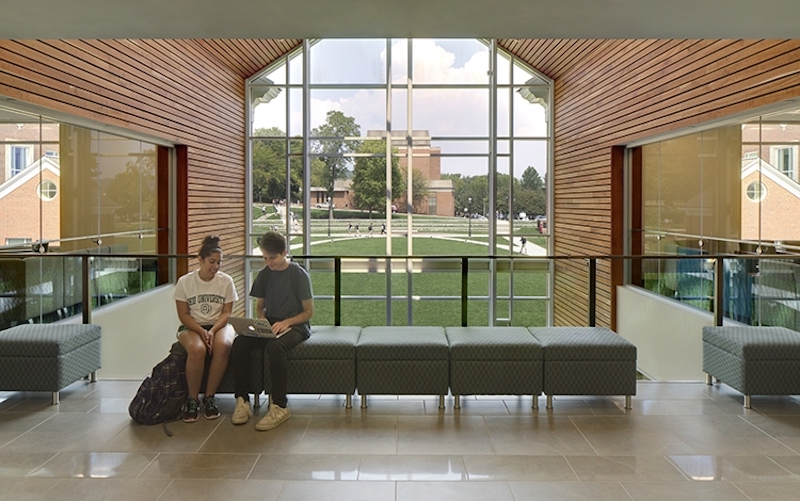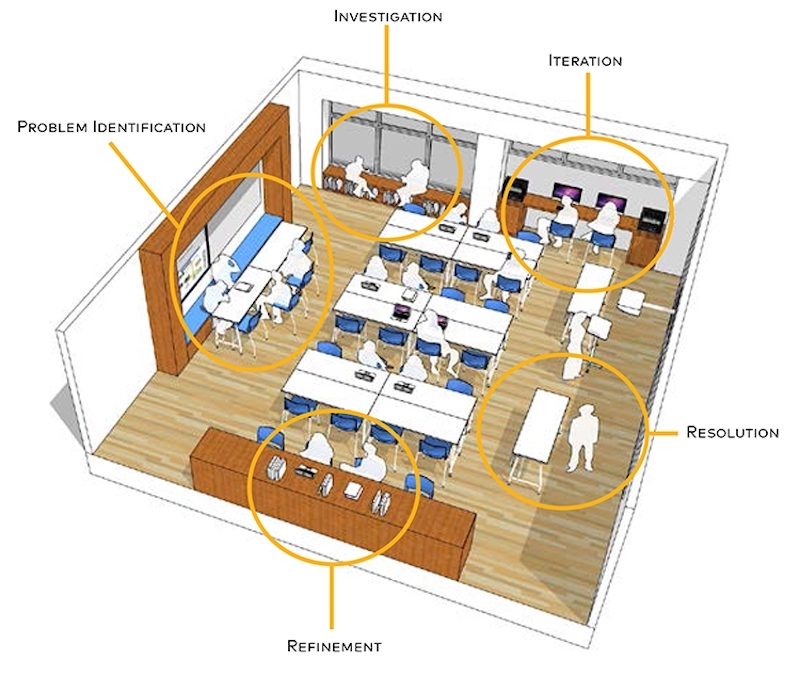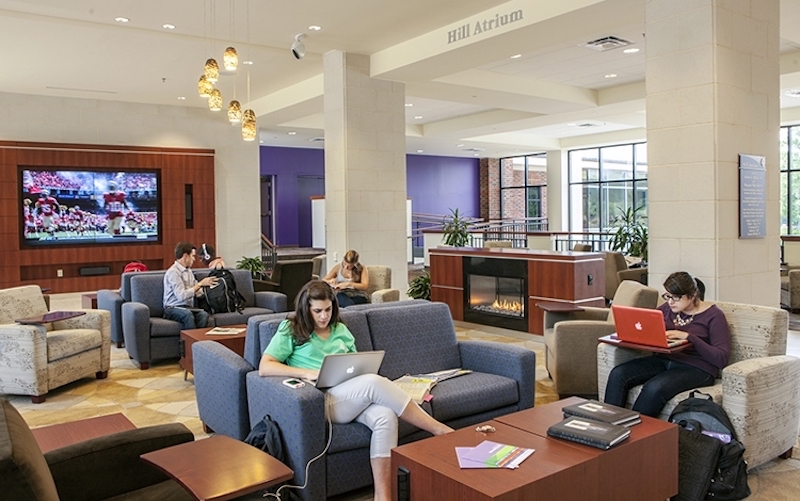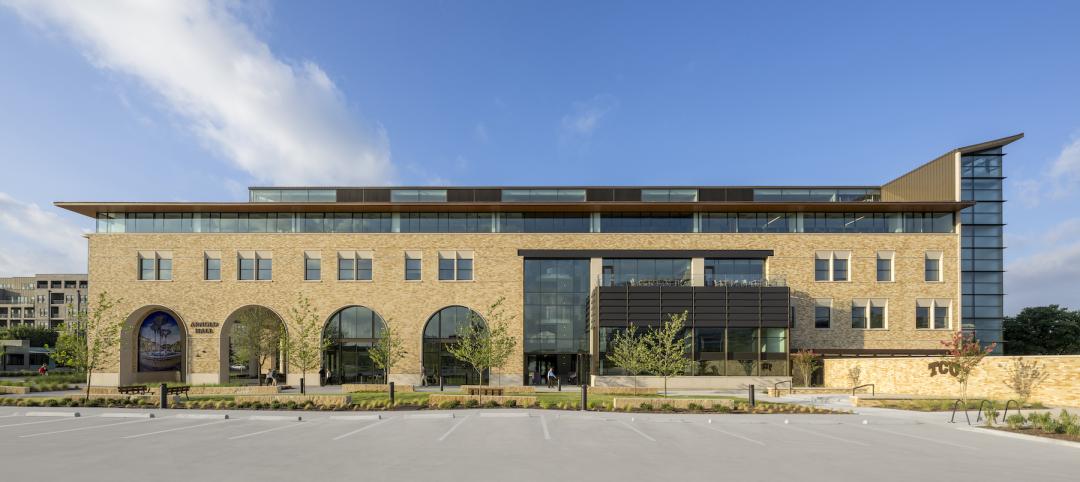Welcome back for part three of the series, Designing for the Next Generation of Student Life. One of the major shifts in higher education today is the reality that Colleges and Universities are placing incredible emphasis on interdisciplinary studies. They are acknowledging that siloed academic disciplines don’t necessarily model today’s professional endeavors and are likely limited in solving some of the world’s greatest (or simplest) challenges. As this idea has taken hold, many Colleges and Universities are emphasizing interdisciplinary studies across campus. Along with this notion comes the realization that most campuses already have concentrations of students from different academic backgrounds in student housing, dining, sports and recreation, and student unions. This captive and blended audience seems to be the perfect opportunity to integrate academic and student life space into one holistic endeavor. Today, more than ever, Student Life is key to the academic enterprise!
This idea is not necessarily a new one. Several Universities have incorporated student interest groups, living / learning communities (LLCs), and residential colleges into Student Life in the past. But what’s different today is a defined curriculum around interdisciplinary study, teamwork, and academic experimentation, not just proximity or recreational interests. Many insitutitions have implemented degrees designed for academic cross-over (AKA portfolio programs), seminar courses that give students exposure to subjects outside their chosen major, and class projects designed to bring multiple academic majors together.
Since many academic departments have been concentrated in their own buildings or portions of campus, bringing these disciplines into a shared facility is fairly new territory. It also poses some basic challenges, such as shared space, equipment, furnishings, and faculty support. If we take this a step further and ask whether academic and student life spaces can be integrated, the same kinds of challenges present themselves, plus others: different funding sources, scheduling, security, maintenance, and hours of operation. How would a classroom in a residence hall be reserved, or maintained, or paid for over time? Who would be responsible? And importantly, how would this space be tuned to an interdisciplinary focus? These are the questions that set the stage for a new design opportunity.
LEARNING COMMONS
 The Learning Commons at Ohio University.
The Learning Commons at Ohio University.
At some institutions with remote centers of student activity, the University has employed a ‘learning commons’ concept to integrate academic and student life. This idea often dedicates the first floor or basement level of a few, dispersed residence halls to a casual suite of soft furniture, group tables, classrooms, and study rooms that are open to the entire neighborhood (or grouping of residential buildings). This concept requires a careful coordination of how neighborhood residents access the learning commons and how building residents access the upper floors in order to maintain security. But, the results have been groundbreaking. Not only has the learning commons resulted in valuable academic areas, but it has received rave reviews from teachers and students. Teachers are appreciating the increased exposure to students of varied academic disciplines, causing faculty-in-residence suites to be in higher demand. Students love the ability to walk downstairs to attend a class, study, or collaborate (in their pajamas if they wish) versus long travel distances to the campus core. And in many cases, the academic side of the house has agreed to share the maintenance and funding expenses for this unique learning space.
MULTI-MODAL CLASSROOM
 Multi-modal classroom prototype.
Multi-modal classroom prototype.
One of the keys to interdisciplinary learning is a new kind of venue, one that encourages multidisciplinary discovery. With a bit less emphasis on individual study and greater focus on collaborative problem solving, we often see project-based learning as an excellent backdrop for interdisciplinary studies. Project-based learning can take many forms but it follows a consistent process: real-world problem identification, investigation, iteration, refinement, and resolution. While each of these steps can represent their own space type, it might be more powerful to imagine one space that hosts all five activities at once. This is in direct counterpoint to the single mode classroom. In the past we have seen conference rooms, computer labs, woodshops, maker-spaces, and even active learning classrooms serving as project-based learning zones, but these rooms tend to fall into a single-use mode. Perhaps the future of interdisciplinary learning is one space that specifically and continuously fosters each step in the project-based learning process.
DISTANCE LEARNING…ON CAMPUS
Another major force in the combination of academic and student life space is the emerging priority of distance (or digital) learning. With the recent events related to the Coronavirus (COVID-19), we anticipate that this topic will receive dramatically increased attention.
Many research studies have reported that in-person instruction and collaboration is still incredibly valuable, but the ability to hit ‘pause’ or ‘replay’ on a recorded piece of instruction is equally valuable. And surprisingly, students prefer this blended learning format regardless of whether they live on campus or off. As a result, we are seeing that blended learning isn’t just for remote or commuter students, it’s critical for on-campus residents as well. What this means for academic spaces in the student life realm is that they are likely to incorporate two specific aspects. Some spaces will be geared toward multidisciplinary collaboration, while other areas will be geared toward personalized, distance learning. We can predict that immersive video, individual study booths, and even virtual reality and augmented reality studios are part of this picture.
FUSION BUILDINGS
Here’s another possibility. What if a large residential complex were to host several academic classrooms and pair those classrooms with the University’s academic disciplines that need and want space in the Student Life realm? This idea is already upon us with the emergence of fusion or mixed-use buildings. I recently worked on a design competition where a number of classrooms were planned for a University residential complex. Each of these classrooms could have been reserved by academic departments wishing to promote their program or associated more specifically with the school’s individual "colleges". The objective was to showcase each of the school’s major fields of study outside of a singular building, making those investigations more visible and accessible to the entire student body and university community. As an added benefit, the colleges may choose to use this extra academic space to manage a temporary rise in enrollment, offer an additional class, or defer renovation or new construction needs in their academic department.
NEW ACADEMIC SUPPORT
Several research studies over the years have suggested that student success is positively influenced the longer a student lives on campus. Much of the reason for this increased performance is attributed to simply being surrounded by fellow students, faculty, and staff who care that the student is there and doing well. We can imagine that integrating academic space into the student life realm will only improve this student success potential. For example, tutoring spaces have historically been centralized (often located at the campus library), but we see faculty and peer tutoring becoming more distributed in the future, with open and enclosed spaces in the student union or residence halls. Speaking of student unions, we are seeing a huge increase in requests for small group study rooms and casual study areas, turning what was the social hub of campus into an academic center as well.
As our world continues to grow in complexity and employers look for graduates with greater interdisciplinary, collaborative problem solving skills, we are confident that this blend of social and intellectual learning will continue to grow on the higher education campus. Please feel free to share with us your experience with student life spaces becoming more academically aligned.
Related Stories
Libraries | Oct 30, 2024
Reasons to reinvent the Midcentury academic library
DLR Group's Interior Design Leader Gretchen Holy, Assoc. IIDA, shares the idea that a designer's responsibility to embrace a library’s history, respect its past, and create an environment that will serve student populations for the next 100 years.
Healthcare Facilities | Oct 18, 2024
7 design lessons for future-proofing academic medical centers
HOK’s Paul Strohm and Scott Rawlings and Indiana University Health’s Jim Mladucky share strategies for planning and designing academic medical centers that remain impactful for generations to come.
University Buildings | Oct 15, 2024
Recreation and wellness are bedfellows in new campus student centers
Student demands for amenities and services that address their emotional and mental wellbeing are impacting new development on college campuses that has led to recreation centers with wellness portfolios.
Higher Education | Oct 14, 2024
Higher education design for the first-gen college student
In this Design Collaborative blog, Yogen Solanki, Assoc. AIA, shares how architecture and design can help higher education institutions address some of the challenges faced by first-generation students.
University Buildings | Oct 9, 2024
Des Moines University Medicine and Health Sciences opens a new 88-acre campus
Des Moines University Medicine and Health Sciences has opened a new campus spanning 88 acres, over three times larger than its previous location. Designed by RDG Planning & Design and built by Turner Construction, the $260 million campus features technology-rich, flexible educational spaces that promote innovative teaching methods, expand research activity, and enhance clinical services. The campus includes four buildings connected with elevated pathways and totaling 382,000 sf.
University Buildings | Oct 4, 2024
Renovations are raising higher education campuses to modern standards
AEC higher ed Giants report working on a variety of building types, from performing arts centers and libraries to business schools. Hybrid learning is seemingly here to stay. And where possible, these projects address wellness and mental health concerns.
Museums | Oct 1, 2024
UT Dallas opens Morphosis-designed Crow Museum of Asian Art
In Richardson, Tex., the University of Texas at Dallas has opened a second location for the Crow Museum of Asian Art—the first of multiple buildings that will be part of a 12-acre cultural district. When completed, the arts and performance complex, called the Edith and Peter O’Donnell Jr. Athenaeum, will include two museums, a performance hall and music building, a grand plaza, and a dedicated parking structure on the Richardson campus.
Higher Education | Sep 30, 2024
Studio Gang turns tobacco warehouse into the new home of the University of Kentucky’s College of Design
Studio Gang has completed the Gray Design Building, the new home of the University of Kentucky’s College of Design. In partnership with K. Norman Berry Associates Architects, Studio Gang has turned a former tobacco warehouse into a contemporary facility for interdisciplinary learning and collaboration.
University Buildings | Sep 24, 2024
Texas Christian University opens new medical school building
The facility is designed and programmed to anticipate advances in medicine and technology.
Designers | Sep 20, 2024
The growing moral responsibility of designing for shade
Elliot Glassman, AIA, NCARB, LEED AP BD+C, CPHD, Building Performance Leader, CannonDesign, makes the argument for architects to consider better shade solutions through these four strategies.

















